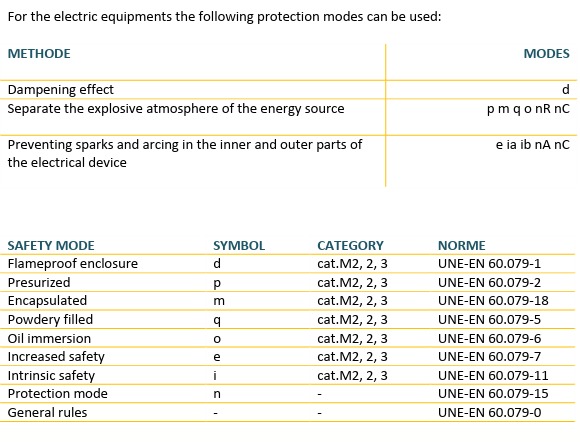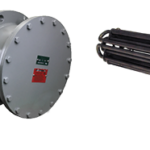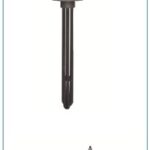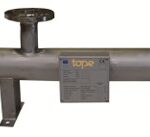Immersion Heaters UK can supply you with an ATEX Immersion Heater that meets the EU standard for explosion-proof and flame-proof devices: ATEX (“ATmosphere EXplosive”).
Call Jamie on 01827 215684 to discuss your specific needs. There really is no substitute for a conversation, especially with requirements as exacting as an ATEX Immersion Heater.
- Bespoke to suit your specific requirements.
- 1kw to 2000kw power rating.
- 240 or 415 volts with other voltages available for equipment destined for other countries.
- Various flange size and material to suit application,
- ‘Stood off‘ terminal enclosures available for high temperature applications.
- Available with thermostats and/or safety cut-outs,
- Incoloy 800 or stainless steel sheathed elements,
- Available with a range of IP rated terminal enclosure to suit.
- Flameproof and explosion-Proof ATEX certified Exd constructions available on request.
Useful Flanged and ATEX Immersion Heaters Information.
What is ATEX?
ATEX is the name commonly given to the two European Directives for controlling explosive atmospheres:
1) Directive 99/92/EC (also known as ‘ATEX 137’ or the ‘ATEX Workplace Directive’) on minimum requirements for improving the health and safety protection of workers potentially at risk from explosive atmospheres. The text of the Directive and the supporting EU produced guidelines are available on the EU-website. For more information on how the requirements of the Directive have been put into effect in Great Britain see the information in the section Explosive atmospheres in the workplace below.
2) Directive 2014/34/EU (also known as ‘ATEX 114’ or ‘the ATEX Equipment Directive’) on the approximation of the laws of Members States concerning equipment and protective systems intended for use in potentially explosive atmospheres. The text of the Directive and EU produced supporting guidelines are available on the EU website. For more information on how the requirements of the Directive have been put into effect in Great Britain. See the section on Equipment and protective systems intended for use in explosive atmospheres.
The term explosive atmosphere is defined as a mixture of inflammable solids – in the form of gases, vapour, fog or dust – with air under atmospheric conditions causing the combustion to spread to the entire unburned mixture after ignition. Atmospheric conditions are normally defined as -20ºC to +40ºC, pressure 0.8 to 1.1 bar.
Zone classification.
Hazardous areas include places, environments, premises and operational circumstances where explosive atmospheres can be present. To indicate the probability of explosion in the above mentioned hazardous areas, these are divided into zones; 3 zones for gases and 3 zones for dust depending on how often the danger of explosion is present Zone 0 (gases) or zone 20
(dust): are areas where danger of explosion is always or very often present.
Zone 0 (gases) – Zone 20 (dust)
Areas where danger of explosion is always or very often present.
Zone 1 (gases) – Zone 21 (dust)
Areas where danger of explosion is occasionally present under normal operating conditions.
Zone 2 (gases) – Zone 22 (dust)
Areas where danger of explosion is rarely or only shortly present.
The areas are classified in function of the escape sources that are points or localizations from where the combustible substance may escape and form an explosive mixture with the air. According to the escape frequency they are classified in:
Grade of continuous escape:
Escape source that it originates an explosive atmosphere that can exist continually, or it can be expected to remain during long periods or during short periods but very frequent.
Grade of secondary escape:
Unexpected source during the normal operation, and if it generates escape, it is probable that it makes it infrequently or for short periods of time.
The objective is that the areas where the probability of explosive atmosphere is higher, the smaller may be the probability of an ignition source is activated. The following table show the relationship between areas and equipments.

How to classify the equipments which are installed in explosive atmospheres.
The equipment and protection systems for explosive atmospheres are classified according to different approaches. These classifications, are marked on the materials, allowing a clearer indication to the user for their sure employment.
For the state of the combustible substance, in classes:
- Class I: the combustible substance is presented in form of gas, vapour or fog.
- Class II: The combustible substance is presented in form of combustible dust.
For the industrial atmosphere in that it is foreseen if installation, in groups:
- Group I: consists of electrical devices applied in explosive atmospheres in areas such as asworks and mining. Devices categorised as group I are applicable when the danger of explosion is caused by methane, coal dust or a mixture of
these. In case that coal dust forms a layer on the device a maximum surface temperature of 150ºC is admissible. When the deposit of a coal dust layer is not possible a maximum surface temperature of 450ºC is allowed. - Group II: Electrical devices in hazardous environments (excluding group I) above ground level. For this group the admissible surface temperatures only count for executions of devices which meet the requirements of the temperature classes.
Initiation of the Explosion.
The initiation of the explosion for electric arch or for flame, and of the EMI (minimum energy of Ignition) cone a measure of the sensibility to the electric arch, the Group II it is subdivided in Subgroups:
- Subgroups IIA EMI=250 μJ IEMS=0.92mm
(Ref. Methane) - Subgroups IIB EMI=96 μJ IEMS=0.65mm
(Ref. Ethylene) - Subgroups IIC EMI=20 μJ IEMS=0.35mm
(Ref. Hydrogen)
For the ignition source to the initiation of the explosion for contact with a hot surface, in Temperature Classes.
The chart shows the applicable classification ,Class I, Group II, being considered an ambient temperature of 40ºC.
Temperature classes
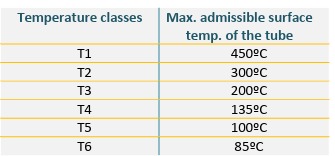
To these effects for the case of mines with firedamp (Group I), a temperature superficial maxim of 450ºC is admitted if it is only considered the methane, but that it decreases to 150ºC if it can be formed a layer of dust of coal on the surface of the team.
TEMPERATURE CLASSES
The highest admissible surface temperatures are applied for temperature group T1; the lowest for temperature group T6. An electrical heater which fulfils the requirements of temperature class T4 automatically meets the standards of T1, T2 and T3.
TEMPERATURE CLASS T1
Gas or vapour mixtures with an ignition temperature >450ºC and a maximum admissible surface temperature of the electrical device of 450ºC. T1 includes e.g.: propane, carbon monoxide, ammonia, acetone, benzene, methane, hydrogen.
TEMPERATURE CLASS T2
Gas or vapour mixtures with an ignition temperature >300ºC and a maximum admissible surface temperature of the electrical device of 300ºC. T2 includes e.g.: butane, butyl acetate, ethanol, isopentane.
TEMPERATURE CLASS T3
Gas or vapour mixtures with an ignition temperature >200ºC and a maximum admissible surface temperature of the electrical device of 200ºC. T3 includes e.g.: petrol, oil derivatives, in principal petrochemical industry.
TEMPERATURE CLASS T4
Gas or vapour mixtures with an ignition temperature >135ºC and a maximum admissible surface temperature of the electrical device of 135ºC.
TEMPERATURE CLASS T5
Gas or vapour mixtures with an ignition temperature >100ºC and a maximum admissible surface temperature of the electrical device of 100ºC. T5 derives its practical meaning in the processing of carbon disulphide and the production of textile fibres.
TEMPERATURE CLASS T6
Gas or vapour mixtures with an ignition temperature >85ºC and a maximum admissible surface temperature of the electrical device of 85ºC. T6 is based only on the processing of ethyl nitrite. The environmental temperature in the calculations is
40ºC. An environmental temperature which deviates from the above mentioned 40ºC is admissible. In this case the chosen temperature must be mentioned explicitly on the device.
For the probability that the equipment contributes an energy source that causes the explosion, in Categories:
In function of the level of security two categories are settle,for the Group I (M1 and M2) and
three categories for the Group II (1, 2 and 3)
Category M1 and 1:
Includes the designed quipments and, if it is necessary, equipped with special protection means, so that they can work inside the operative parameters specified by the manufacturer and to assure a very high protection level. The equipments of this
category should be foreseen to be used in atmospheres in those that take place in a constant way, durable or frequent explosive mixtures of gases, vapours, fog or dust. The equipments of category M1 are usually dedicated to work in a continuous way with the presence of explosive atmospheres. These equipments should even assure the protection level in the case of uncommon trouble so that:
- In the event of failure of one of the protection means, at least a second independent element assures the required protection level. -In case two independent damages take place, the required protection level is assured.
Category M2 and 2:
Includes the equipments designed to be able to work under the practical conditions fixed by the manufacturer and based on a high protection level. The equipments of this category are dedicated to be used in an atmosphere in which is probable the
presence of an explosive atmosphere and they will assure the required protection level, still in the case of frequent damage. The equipments of category M are usually those that, in the event of detection of an explosive atmosphere (above the level of
concentration fixed regulation), it will be possible to cut the electric power.
Category 3:
Includes the equipments designed to be able to work under the practical conditions fixed by the manufacturer and to assure a level of normal protection. The equipments of this category are dedicated to be used in an atmosphere in which is not very
probable and uncommon the formation of explosive mixtures, and when it happens it is of short duration.
1.5 Which protection exists for the ATEX equipment?
For electrical equipment the following protection modes can be used:
